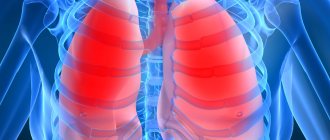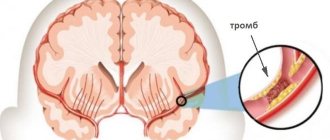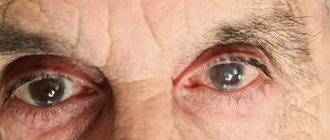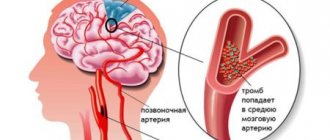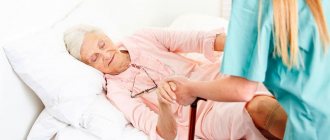Vascular dementia develops as a result of impaired cerebral circulation. It is the second most common form of dementia after Alzheimer's disease. In amateur circles these two concepts are often confused.
Attention! “Vascular dementia” is a general term for neurological disorders caused by disturbances in the blood supply to brain tissue. Doctors use different classifications, but most often use ICD-10.
There are multi-infarction (ischemic or hemorrhagic), subcortical vascular and mixed (cortical and subcortical) dementia. Vascular dementia accounts for about 10-15% of all forms of dementia. Another approximately 20% are classified as mixed forms of dementia.
Why does vascular type dementia develop?
The cause of the development of pathology is an acute or chronic disturbance of cerebral blood flow.
Due to the fact that the tissues partially or completely do not receive the required volume of blood, neuronal necrosis is observed. An acute disorder can be triggered by ischemic (acute cerebrovascular accident due to blockage of cerebral arteries) or hemorrhagic (acute cerebral circulatory disorder developing due to rupture of intracerebral vessels) strokes. Factors that can provoke an ischemic or hemorrhagic stroke include:
- arterial hypertension (high blood pressure);
- heart diseases;
- diabetes mellitus (atrial fibrillation);
- taking narcotic substances;
- elderly age;
- overweight.
Stroke also develops for psychological reasons such as the presence of severe stress and prolonged emotional overstrain.
Chronic circulatory disorders usually go unnoticed. Dementia develops gradually as a result of blockage of small vessels due to atherosclerosis or insufficient volume of delivered blood due to cardiovascular failure. Due to the presence of compensatory mechanisms in the initial stages of dementia, it is almost impossible to identify it.
Diagnostics
To confirm the diagnosis, the patient is also examined by a neurologist and a psychiatrist. A diagnostic examination helps determine the number and location of foci of necrosis.
- Ultrasound, angiography. The condition of the cerebral arteries is determined.
- Electroencephalography.
- General and biochemical blood test.
Most patients do not understand that they have dementia, so monitoring stroke patients from family and friends is very important.
What is subcortical vascular dementia?
Another name for the disease is Binswanger's disease. It is a subtype of vascular dementia in which the lesions are localized in brain structures located below the cortex. Cognitive disorders include symptoms such as:
- increased fatigue;
- decreased performance;
- headache;
- sleep disorders;
- difficulty pronouncing words and swallowing (pseudobulbar syndrome);
- fecal and urinary incontinence;
- walking disorder (abasia).
Vascular dementia (dementia) is a medical phenomenon in which a person loses his mental abilities due to the destruction of blood vessels in the brain.
Vascular dementia occurs in fairly common cases of stroke as a complication. Statisticians provide data that about 10-40% of patients are susceptible to this.
The risk of developing dementia after a stroke occurs in the following cases:
- the presence of bad habits that significantly affect health (smoking, alcoholism);
- low intelligence;
- stroke of the left side of the brain;
- having problems with the brain due to other diseases.
A significant reason can be considered the presence of other serious diseases in a person that also affect the body (diabetes mellitus, heart failure, atherosclerosis, hypertension, etc.).
Content
How to recognize it?
Behavior after a stroke varies among many patients, some lose practical skills and physical mobility, others become weaker mentally. A combination of different manifestations also occurs. The affected area plays an important role in the formation of symptoms:
- Focus in the cerebral cortex . Slurred speech, loss of practical skills, disorientation in space.
- The lesion is in the subcortex . Inattention, absent-mindedness, poor facial expressions, hysteria, slow and uneven gait, depression.
Sometimes the signs are combined, and the pathology can develop due to existing diseases.
Other symptoms characteristic of dementia after a stroke:
- A person has almost no control over half of his body.
- Urinary incontinence is observed in 30% of cases.
- Loss of intelligible speech, writing and reading skills.
- Progressive sclerosis.
- Agnosia is the loss of the ability to recognize people and objects and evaluate them.
- The patient cannot move on his own.
- Frequent mood swings, depression, tendency to panic attacks.
- The appearance of delusions or hallucinations.
Identifying dementia in the early stages helps preserve identity and make life easier for the patient after a stroke.
Treatment of vascular dementia
Dementia after a stroke is treated comprehensively:
- Ensuring patient safety. To do this, the degree of ability to work and the possibility of independent maintenance is determined. The problem is that the patient may simply get lost and not make it home, or lose the key to the front door. For this purpose, domestic workers, caregivers or private home health services are hired.
- Formation and organization of everyday life. Thus, patients are recommended to keep a diary, schedule or other methods of self-organization, where they could note taking pills, write down thoughts and upcoming events.
- Drug therapy. It is used in psychotic conditions when the patient poses a threat to his life and the lives of those around him.
Life expectancy with dementia depends on the adequacy of treatment and care. At the first stage, the doctor prescribes diagnostic tests to differentiate dementia from other diseases. Treatment of senile dementia is based on eliminating the symptoms of the disease and reducing the risk of dementia progression. Dementia is an incurable disease, the course of which depends on many factors - age, gender, type of dementia, concomitant diseases, adequate treatment and care. A calm environment and lack of stress help reduce the risk of progression of senile dementia.
Doctors recommend a special diet, vitamin therapy, music therapy, aromatherapy, acupuncture and other methods that improve brain activity. The average life expectancy of a young patient with dementia can be about 7 years; older people with dementia live on average from 7 to 15 years. By contacting the Yusupov Hospital, you will receive medical care at the European level: they will carry out the necessary diagnostics, select the optimal therapy and rehabilitation program.
You can make an appointment with a neurologist by phone.
Preparations prepared from plants will help in the initial stages of dementia:
- It is beneficial to take a glass of blueberry juice daily or eat a handful of fresh berries. They will help improve your memory.
- The patient's increased excitability can be relieved with a decoction prepared from 2 tablespoons of fennel fruits along with crushed valerian root. The mixture of herbs is poured into two glasses of hot water and boiled for ten minutes. After an hour of infusion, filter the drink and drink a glass in the morning and evening.
- Fifty grams of crushed rowan bark is poured into a glass of water and put on fire. Bring to a boil, boil for five minutes, then leave for 5 hours. The strained broth is taken in a quarter of a glass 5 times a day.
- Healing baths will calm the patient, to which you need to add an infusion of a mixture of rosehip roots and juniper branches or calamus roots, lemon balm leaves, yarrow, peppermint, wormwood, and pine buds taken in equal quantities. It is better to carry out water procedures in the evening for twenty minutes. The duration of treatment is ten sessions. Then they take a two-week break.
- Melissa and lavender oil calms the patient's nervous system. A few drops can be applied to the patient’s skin when performing a massage.
The use of folk remedies will have a beneficial effect on the condition of a person suffering from dementia.
Vascular dementia is irreversible: dead brain cells and neurons are not restored.
In this regard, treatment is symptomatic and is aimed at improving the patient’s quality of life and slowing down pathological processes.
First of all, measures are taken to help restore blood circulation in the brain tissue.
For this purpose, drugs are prescribed that do not allow platelets to stick together and create “plugs” in blood vessels, neuroprotective drugs, as well as drugs that improve metabolism in brain cells and tissues.
The treatment regimen, which is always developed individually for each patient, most often contains the following drugs:
- Kavinton (improves blood circulation);
- Cebrolysin (neuroprotector);
- Rivastigmine or Memantine (improves concentration and stabilizes the psyche);
- sedatives (with the development of depression or anxiety due to pathology).
Unfortunately, there are no ways to combat vascular dementia today. Specialists can only delay the approach of the final stage of the disease, but much in this case depends on the patient himself.
At the first signs of such an illness, you should immediately seek help from a doctor, and to reduce the risk of developing the disease, you should give up bad habits, add fresh vegetables and fruits to your diet, and lead an active lifestyle (exercise, take daily walks).
Dementia is most common in older people, but cases of symptoms of dementia not uncommon in people of working age. The reason...
What drugs are prescribed to treat vascular dementia?
In cases of established dementia due to improper treatment of stroke, drug therapy is aimed at smoothing the clinical picture. Drugs are prescribed to improve cerebral circulation (Curantil), psychostimulants (Mesocarb), nootropics (Piracetam), vitamin complexes with a high content of B vitamins, tranquilizers (Phenozepam), antidepressants (Elycea, Amitriptyline, Fluoxetine).
The drugs are combined with each other depending on the clinical manifestations of the disease. It is also worth paying attention to concomitant diseases to prevent a stroke in the future. To train your memory, it is recommended to read books and solve all kinds of puzzles. Knitting or playing the piano helps improve hand motor skills.
The diet should be balanced, replenishing missing microelements - mandatory consumption of fermented milk products, fish, nuts, fruits and vegetables. A psychotherapist can help you cope with the condition, and to maintain vitality you need to periodically engage in your favorite hobby, exercise, and take walks in the fresh air every evening.
There are two groups of causes of aggressive behavior: organic (damage to areas of the brain) and functional (reaction to loss of movement or sensitivity).
Psychosis develops gradually and may not appear until several months later. There is a certain dependence: when a pathological focus forms in the left hemisphere, psychosis develops immediately after an ischemic attack. If the focus is on the right, the event may develop in a year or more.
In most cases, aggression occurs in elderly patients. It is dangerous because a person can cause harm to himself and others.
Obsessive ideas and actions, rejection of your friends, hallucinations, and delusions may appear. At the same time, the person himself has no criticism.
If you cannot eliminate mental disorders on your own, you must immediately call an emergency medical team. Before medical workers arrive, you should not leave the patient alone in the room, make sudden movements or turn off the lights.
What to do?
It is known that the recovery period after a stroke lasts up to 2 years. Restoring lost functions requires considerable effort and patience. With this disease, you should not expect quick results. Therefore, it is important not to lose hope and to support the patient in every possible way during the rehabilitation period. There are many examples where the neurological deficit completely disappears.
If the patient has become aggressive, the following measures are taken:
- classes with a neuropsychologist. Cognitive behavioral therapy, standard rational psychotherapy, transpersonal psychotherapy are effective;
drug therapy;- distraction methods;
- sanatorium-resort treatment after the acute period;
- creating a safe indoor environment;
- relaxing physiotherapy. A new method is magnetic stimulation, which helps eliminate disorders that are not controlled by antipsychotics and antidepressants.
Of course, the caregivers themselves need to be in a calm, balanced state and not show strong emotions.
In some cases, motor and other functions are not restored. The task of the psychologist and the patient’s relatives is to help him live in new conditions and accept himself.
The person must be under constant supervision. The guarantor of his safety will be you or a nurse, whose tasks will include monitoring the intake of medications and adherence to diet.
It is important to understand that the treatment of certain disorders of the mental state of a post-stroke patient (especially if such a patient was prone to depression before the attack) is best coordinated with a neurologist and psychiatrist.
Sometimes such treatment should begin simultaneously with general rehabilitation therapy, literally, from the very first day of hospital stay, sometimes such treatment can begin after discharge.
At the same time, depending on the specific clinical picture, doctors try to select those medications that have the necessary restorative (for the psyche) properties, possibly antidepressants or sleeping pills.
Naturally, the prescription of such drugs can only be individual, and the dosage of such drugs can often change during the treatment itself.
Unfortunately, today medicine cannot offer drugs for the treatment of dementia after a stroke, since they have not yet been developed. The main goal of the rehabilitation course is to alleviate the symptoms of dementia and stop its development. The course of treatment is prescribed only by a specialist in this field of medicine; in no case should you self-medicate such an ailment.
The medications to be taken by the patient are prescribed by a neurologist and psychiatrist only after a comprehensive examination has been carried out. The most common drugs used are donepezil, rivastigmine, memantine and galantomine.
A person does not take only one type of drug. A specially developed system is used that combines medications.
Mechanism of development of cognitive impairment
The main role in the development of mental disorders in dementia is played by irreversible changes in the structure of the brain due to numerous vascular pathologies, which result in the development of acute oxygen deficiency (ischemia). The main symptoms directly depend on the location of the lesions.
Vascular dementia with the appearance of foci of ischemia in the area:
- the midbrain is characterized by darkness and confusion, speech disorders;
- hypocampus (in the temporal part of the brain) – complete or partial memory loss;
- frontal lobes – loss of adequacy, development of characteristic psycho-emotional reactions (fixation on a phrase, action);
- subcortex – loss of concentration, writing, counting skills, ability to analyze and reproduce information;
- in different areas of the brain is fraught with the appearance of a severe form of dementia with a combination of many symptoms of mental and neurotic disorders.
If the lesion is large or located in a highly specialized area, and a critical disruption of the blood supply occurs suddenly (stroke), then symptoms of dementia can appear quite quickly (2-3 months after the attack in 30%).
In other cases, the disease progresses slowly, manifesting itself in older people (after 60–65 years in 60%) with a complex of associated risk factors (lipid metabolism disorders, diabetes mellitus, arterial hypertension, etc.).
Dementia and stroke inextricably accompany each other in varying degrees of clinical severity. There are two main pathogenetic links in acute cerebrovascular accident:
- As a result of blockage of the lumen of a blood vessel by an atherosclerotic plaque, thrombus or atherosclerotic masses, a lack of blood appears in the brain and an ischemic stroke is formed, vascular-type dementia in 30% of cases.
- When the wall weakens, a protrusion (aneurysm) appears, and arterial or intracranial pressure increases, the risk of hemorrhagic stroke with rupture of the hemovascular membrane is high.
Dementia after hemorrhagic stroke or ischemic cerebral infarction has an extremely high risk when more than 50 ml of brain volume is affected. Cognitive disorders manifest themselves acutely, noticeable in the first 3-6 months. The development of changes after six months can be attributed to another type of dementia.
After a single stroke, cognitive impairment may not change in severity, but in some cases there is a slow decline. A step-like course is typical and often has the same localization, severity and etiological factor.
People over 60 years of age may experience so-called “silent” strokes located in the white matter of the brain. Etiologically they manifest themselves against the background of a sharp decrease in blood pressure (collapse), diseases of the heart and coronary vessels, and other severe somatic pathologies. It is perceived as senile dementia, clinically manifested as forgetfulness, inability to dress independently, prolonged mindless walking, inability to recognize a close relative the first time, etc.
When dementia occurs after a stroke, how long they live is directly related to repeated episodes of acute cerebral circulatory disorders. High mortality with recurrent stroke after 3-6 months. The risk of death is in every 2-3 patients.
Flow options
Epidemiological observations show that the risk of dementia increases with recurrent stroke. Post-stroke cognitive disorders are heterogeneous. The heterogeneity of neurological, psychological characteristics and natural dynamics after an acute cerebral catastrophe is noted.
Variants of post-stroke cognitive impairment CauseDescription
| Single stroke | Damage to the so-called “strategic” zones and the sharp development of dementia after stroke are registered only in 5% of cases as a result of a single cause. This rare variant is characterized by neuropsychological characteristics when affecting a certain area:
|
| Decompensation of existing vascular dementia | This type of dementia is most often recorded, accounting for 40% of all cases after a stroke, the prognosis of the disease is relatively favorable. With additional rehabilitation measures, it is possible to maintain vital and cognitive functions. Clinically – slowing of motor speech and mental reactions. |
| Mixed vascular-degenerative lesion | Cognitive functions are simultaneously depressed, and the neurodegenerative process is often difficult to recognize. The mixed variant progresses rapidly, mnestic disorders are noticeable as in Alzheimer's disease (disadaptation, dysmnesia, amnesia, confabulation*), decreased intellectual productivity, apathy. |
*confabulation – replacing memory lapses with fictitious actions.
Forecast
The prognosis of dementia after a stroke depends on many reasons: age, characteristics of the body, the presence of genetic predisposition and the severity of concomitant diseases. The clinical picture can also vary significantly depending on the number of strokes suffered and the treatment performed. As a rule, the prognosis for dementia is satisfactory. Total personality degradation is quite rare, and regular compliance with all doctor’s recommendations can prolong life for many years.
The mechanism of pathology development
1. Beginner. Signs of dementia are barely perceptible, these are: – instant forgetfulness (failure is observed immediately upon receipt of new information); – deterioration in time and spatial orientation; – insomnia, emotional decline (reduced manifestations of joy and sadness, the person has an apathetic appearance). 2. Early. Occurs with difficulties in choosing words
When talking and writing, forgetting the names and locations of things. Lack of understanding of other people’s thoughts when communicating (requests, reasoning), the emotional state of the interlocutor. The ability to self-care is partially reduced (they cannot do laundry, cook food, clean the room, etc.). Atypical changes in character are observed; tearfulness, aggression, withdrawal into oneself or, conversely, hysterical attacks, a desire to gather more “spectators” around oneself may appear.
. During this period, sick people lose spatial orientation, sometimes do not respond to calls to them, lose the ability to perform household services, often forget the names of loved ones and cannot remember events from the past.
It is possible that such a course of the disease will require constant monitoring of the lives of patients, since they can unknowingly cause harm to themselves and others (leave the water in the tap, gas open, go outside and get lost, etc.).
. The last stage of dementia before death occurs with immobilization of patients, urinary and fecal incontinence, loss of memory and the ability to adequately perceive reality.
In some forms of dementia (Alzheimer's type, alcoholic or schizophrenic), as well as in its mixed course, delusions of persecution, hallucinations, phobias, and mania are observed.
At a severe stage of dementia, a complete collapse of the personality occurs
There are three stages of disease development:
- Easy stage. Intellectual activity is significantly reduced, practical skills remain intact, so the patient can live an independent life.
- Moderate stage. Loss of intellectual activity and many life skills. A person forgets how to use basic things (gas stove, telephone). Someone should be with the patient at all times.
- Difficult stage. Complete collapse of personality, the patient is unable to carry out the simplest hygienic procedures.
These stages are very easy to notice, but the disease cannot be completely cured. Dementia cannot be cured with medications.
Dementia leads to personality degradation. If disturbances were noticed quickly and the patient was provided with timely medical care, then over time these changes stop.
With medication, vigilant monitoring, and reduction of vascular changes, there is a greater chance of recovery.
So, it is important to notice the changes in the patient at the very first stage of the disease, otherwise, the changes will be more serious.
The life expectancy rate for dementia directly depends on the stage and the conditions in which the person lives.
There are three stages of dementia: mild, moderate and severe.
| Stage | Characteristic |
| Light | At first, pathology is reflected only in intellectual activity, without affecting practical skills and abilities. It becomes more difficult for a person to learn new information, but it is not difficult for him to perform previously practiced actions. People with mild dementia are able to cope with life independently. |
| Average (moderate) | At this stage, the patient’s mental abilities are greatly dulled, and most of the previously mastered life skills are lost. There may be difficulties opening the door lock with a key, working with household appliances, or a mobile phone. With pathology at this stage, it is imperative that the patient is regularly supervised. |
| Heavy | At the last stage, a complete and final disintegration of the patient’s personality occurs. A person is absolutely deprived of the ability to live independently; often he cannot even perform minimal hygiene procedures. |
The initial signs of dementia are quite pronounced, so recognizing the pathology is not difficult. This is good, since timely therapy in the early stages of the onset of the disease can slow down the rate of its development.
The disease cannot be completely cured; therapy can only ease the symptoms and alleviate the patient’s condition.
Can it be cured?
Modern medicine cannot yet boast of a panacea for dementia; we are only talking about rehabilitation to alleviate symptoms and stop the development of the disease. A remedy has not yet been invented that could slow down the destruction of nerve cells, block the deposits of abnormal proteins in brain neurons and restore tissue damaged by necrosis.
The course of treatment is prescribed comprehensively, according to a specially developed scheme, with a combination of different drugs.
Medicines
It is very important to take medications during this period:
- Psychostimulants. Increases the stability of the central nervous system against possible stress.
- Nootropic substances. Activate mental activity, improve memory, reduce aggression. Provide nutrition to brain tissue. The most common: piracetam and nootropin.
- Antidepressants.
- Vitamins. Help restore lost brain functions.
- Series to improve blood supply to the brain, which prevent areas of necrosis from expanding. Tavegil and Cavinton are most often prescribed.
- Medicines to improve memory. Mamantin has proven itself well.
Physical therapy sessions are also prescribed, which help restore blood circulation and relieve muscle tightness.
Proper nutrition also helps keep the patient in an acceptable condition. Some medical experiments have proven that with the help of products, the development of dementia can even be slowed down.
It is necessary to include in the diet:
- Curcumin. A substance found in curry seasoning. It is believed that Indians are not susceptible to Alzheimer's disease because they consume these spices daily. Curcumin prevents amyloid plaques from developing in the brain.
- Natural antioxidants: vitamins E, C, coenzyme Q 10, lycopene and beta-carotene.
- Vegetables, fruits, legumes, nuts.
- Olive oil.
- Fish or seafood.
- Cottage cheese, kefir, cheese.
- Red wine in modest quantities.
It is important to know that in the early stages of dementia, appetite can be greatly reduced, and in the moderate stages it can greatly increase. Therefore, the patient needs to be fed in small portions.
If the patient has difficulty swallowing, it is necessary to urgently consult a doctor.
Medicines
Prevention
To avoid relapses of stroke and manifestations of dementia, you need to give up bad habits and establish proper nutrition.
The most important recommendations:
- Select moderate physical activity that is feasible for the patient.
- Monitor blood pressure.
- Find time for mental and intellectual activities.
- Eat foods with low cholesterol levels.
Scientists have compiled a list of natural foods and herbs that help block the development of dementia. If you include them in your diet, the risk of developing dementia after a stroke is significantly reduced.
- Vitamin C. Found in green leafy vegetables and citrus fruits. Helps restore brain function.
- Folic acid . Found in oranges, strawberries, asparagus, peas, papaya.
- Almond. Includes vitamin E. To get the maximum effect, the product should be eaten on an empty stomach, after soaking in water in the evening.
- Sage. Slows down blood clotting, dilates blood vessels, improves blood flow. Relieves attacks of depression and anxiety.
- Ginseng. Helps damaged brain cells recover. You need to drink up to 600 grams of decoction per day; the herb is brewed like tea and left for 15 minutes.
- Milk thistle . The fruits contain seeds rich in silymarin, this substance prevents the loss of connections between brain cells, which manifests itself in dementia. You should take 420 milligrams of extract per day, available in the form of tinctures, tablets or capsules.
- Melissa. Improves the healing of affected brain cells, inhibits the process of memory deterioration, relieves anxiety, and normalizes sleep. Brew like tea: a teaspoon per glass of boiling water, drink 3 servings a day.
- Ginkgo biloba . Contains strong antioxidants that improve memory performance, increase blood flow to the brain, and inhibit the development of dementia. Brew 250 ml of boiling water leaves, 1 teaspoon per serving, drink twice a day.
Although, unlike age-related dementia, post-stroke dementia does not always lead to complete degradation, the risk of disease progression always remains very high. It is possible to avoid such manifestations if you recognize the symptoms in the early stages and immediately consult a doctor. With the help of medications, the patient’s condition can be regulated, keeping it at an acceptable level for existence.
Drugs used
If the symptoms are unclear, the patient usually turns to a therapist or general practitioner.
However, at the first suspicion of brain dysfunction, a person inevitably ends up in the office of a neurologist, who will decide how to treat vascular dementia.
His responsibilities include:
- diagnostics (including identification of the primary disease);
- determining the stage of the disease;
- prescribing a course of treatment and rehabilitation therapy.
Cognitive disorders associated with dementia are often accompanied by mental disorders that can lead to long-term depression.
In this case, a psychiatrist is involved in the treatment. If the patient has reached old age, it is possible to observe a geriatrician (a specialist in age-related diseases).
Treatment of dementia should be carried out comprehensively and pursue the following goals.
- Treatment of the disease that caused the syndrome.
- Elimination of pathological symptoms.
- Treatment of cognitive disorders.
- Prevention of complications.
In the case of dementia resulting from vascular disorders,
. If the cause of the syndrome is a stroke, then the main treatment measures are to eliminate the consequences of this disease.
It is necessary to slow down the process of damage to brain cells and restore the patient’s mental functions. To avoid stroke recurrence, it is important to follow prevention rules, including blood pressure control. This is especially true for atherosclerosis and hypertension.
A person suffering from dementia needs constant care and supervision, because, due to constant forgetfulness, they pose a danger to themselves and others. The use of common household appliances can pose a threat to life and health.
Outpatient treatment is prescribed only if the patient is properly monitored at home. Otherwise, the patient undergoes treatment in a hospital.
Causes
Before proceeding directly to the process of treating the disease, it is necessary to understand the causes. Factors that influence health status:
- regular pressure changes;
- tumor formation;
- diabetes;
- heredity.
All of the above points have a strong effect on the blood. As a result, the blood vessels narrow and the gray matter no longer functions normally.
Leave a request for selection of a boarding house
for an elderly person with dementia
Modern types of treatment
Recovery from a stroke takes a long time and requires patience. To overcome depression, use:
- medications;
- transcranial stimulation;
- electroconvulsive therapy;
- psychotherapy.
Psychotherapeutic methods for treating PD include the cognitive-behavioral method. Patients are explained how to control the disease and taught to think positively.
Cognitive Behavioral Psychotherapy Formula
During therapy sessions, they explain how to cope with everyday and professional problems.
Rehabilitation of post-stroke depressive disorder is carried out using several groups of medications. The patient is prescribed medications:
- antidepressants;
- nootropics - Cerebrolysin, Phenotropil;
- tissue regeneration stimulators - Actovegin;
- regulators of nervous tissue metabolism - Enerion.
Antidepressants are recognized as the most effective treatment for post-stroke depression. Drugs in this group:
- improve cognitive functions of the brain - memory, intelligence, ability to concentrate;
- normalize emotional state;
- contribute to the restoration of neurological disorders.
When signs of depression appear, antidepressants are prescribed; the list of drugs in this group includes the following drugs:
- tricyclics - Amitriptyline, Imipramine;
- sertraline - Zoloft, Stimuloton;
- escitalopram - Elicea Ku-tab, Escitalopram;
- fluoxetine - Prozac, Fluoxetine Lannacher;
- milnacipran - Ixel;
- duloxetine - Cymbalta;
- tianeptine - Coaxil;
- agomelatine - Valdoxan.
In order to lift a patient out of depression, it is necessary to stimulate his mental and physical activity. There should be time in your daily routine to do gymnastics, correct speech, communicate with loved ones, and walks.
If the ability to articulate speech is impaired, the lesson plan includes learning tongue twisters and reading aloud.
To restore fine motor skills of the fingers, the patient is offered:
- collect puzzles, mosaics;
- do modeling from plasticine;
- paint.
Be sure to include walks in the fresh air in your daily routine, as far as the patient’s condition allows.

